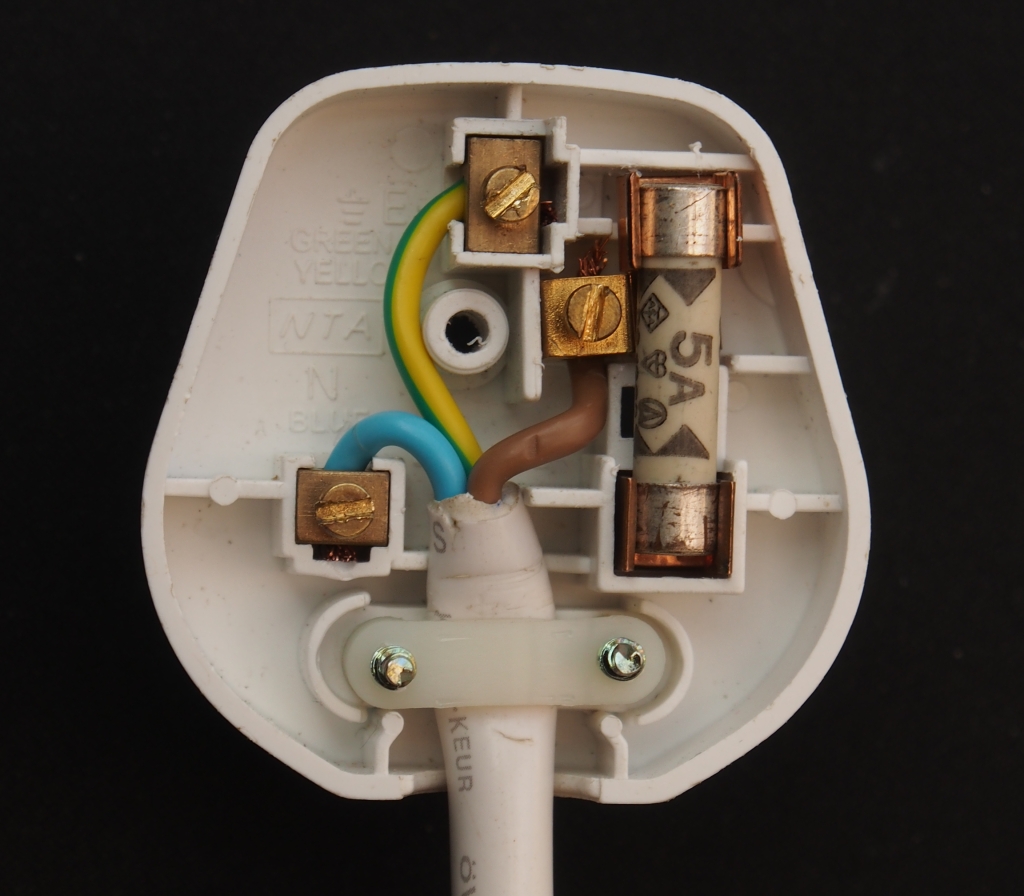There once was a time when the ability to wire a 3-pin plug was an essential skill – but not any more. For reasons of safety, many devices are now fitted with molded plugs that cannot be opened or removed. Nevertheless, the exam board still expects you to be able to identify the essential features of a correctly wired 3-pin plug.
In the UK, electricity is supplied to homes at 230 V as alternating current (AC) with a frequency of 50 Hz. Individual devices connect to this supply via 3-pin plugs. The interior of a correctly-wired UK plug is shown in the photograph below.

The important features of the plug are as follows;
- The live wire, coloured brown and located on the right of the plug, carries 230 V electricity into the appliance (toaster, desk lamp, hair drier, vacuum cleaner, etc). The live wire is connected to a fuse, which is an important safety device (see below).
- The neutral wire, coloured blue and located on the left of the plug, carries the electricity out of the appliance. It has a voltage that is normally just above 0 V.
- The earth wire, coloured yellow-and-green and located at the top of the plug, is an extra connection that provides a safety route to take electricity out of the appliance if a fault develops.
The exam board is very keen on safety, so as well as being able to describe the role of the three wires you must also be able to explain how both fuses and earth wires provide safety protection.
A fuse is like an automatic switch that cuts off the electricity supply if something goes wrong in the appliance. It works by melting a wire that is contained inside the cylindrical fuse housing. In normal use, electricity flows into the plug through one of the pins that slides into the power socket. This pin is attached to the bottom end of the fuse and the live wire is attached to the top end. Electricity must therefore flow through the fuse to get into the appliance.
When the appliance is working normally, it draws a certain current. You should recall that the current used by a device with a certain power rating can be calculated using one of the standard equations;
power = current x voltage
Using this equation we can calculate, for example, that a 1000 W hair drier connected to the UK’s 230 V electricity supply would use a current equal to 1000 / 230. This gives a current of 4.35 A.
If our 1000 W hair drier suddenly started drawing 10 A then we should be worried because it would normally use less than half that current. If we knew that the current had gone so high then we would probably switch-off the hair drier in case we got an electric shock. But we cannot see electricity and hair driers are not fitted with ammeters, so how could we know that a fault has developed?
Fortunately, the fuse provides a automatic switch that breaks the circuit if the current goes too high. All we have to do is ensure that the correct fuse is fitted inside the plug. In the case of our 1000 W hair drier, a 5 A fuse (as shown in the photograph) will do nicely.
There are standard values for fuses and the important thing is to fit the fuse that is as close as possible just above the usual current for the appliance. Common fuses are 1 A, 3 A, 5 A, 10A and 13 A. Three-pin plugs are sometimes called 13-amp plugs because their maximum current (and therefore the maximum fuse) is 13 A.
You might ask what would cause the current to go higher than its normal value? One possibility is that a wire comes loose inside the appliance and touches the casing. If the case is made of metal (or has any metal parts) then electricity could flow into anybody who touches, or is holding, the outside of the appliance. That could be fatal if the electricity isn’t switched-off very quickly but the fuse melts and breaks the circuit, so helping to save lives!
The earth wire works differently and is permanently connected to the metal chassis of the appliance. This might be a metal case or it could be a metal frame inside the appliance. In both situations, if the live wire comes loose then the chances are that it will touch the metal chassis. This means the live wire will connect to the earth wire, which provides a short-cut to get electricity out of the appliance. The quick exit results in a very high current that immediately melts the fuse and breaks the circuit.
It is worth saying that fuses are an old fashioned way to provide safety protection. They are cheap and easily fit inside a plug but they take a bit of time to melt, which means that a person could still get an electric shock (but not a fatal one).
A better solution is to use an electronic circuit breaker that reacts to faults very quickly, so it provides even better protection. Circuit breakers can be reset by pushing a button or flipping a switch without having to fit a replacement fuse, which makes them easier to use for people who are nervous about electricity or don’t understand electric plugs.
